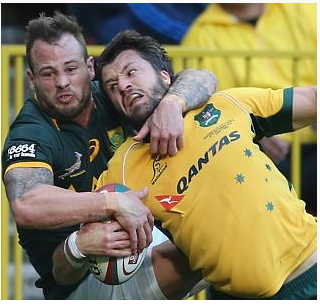After their loss to South Africa on Saturday I couldn’t help but feel there is a real issue with the game plan the Australians are heading onto the pitch with. Understandably post game there was a lot of focus on the last 10-15 minutes, but I think the issues go all the way back to the start of the game.
Bar a couple of moments, the first 20 minutes of the game are spent in or around the Australian half with the Wallabies defending. Any team that tackles for such a prolonged period of time will be tired later on, regardless of what level you are playing. But when you take into consideration that they are defending against a team as physically draining as South Africa you can understand why that sustained period of pressure is going to take its toll both mentally and physically on the squad.
I believe this is one of the reasons why they fell off so badly towards the end.
Sure there was some industrious play by the Wallabies, moving the ball through multiple phases or wide to the 13 channel but that tended to break down due to basic handling errors resulting in giving possession back to South Africa at key moments. Probably more telling for me though was Australia’s inability to clear their lines when the pressure was mounting. Some people call it “exit strategies”, I call it “hoofing the ball down the other end”. Whatever, the point is in the first 20 minutes alone only one defensive clearing kick manages to hit touch and that’s for a net gain of 10 meters.
That is an issue and in the video below I’ve pulled together some footage to illustrate what I’m seeing with the Wallabies exit strategies.
Exiting your own half is a major part of any game plan, and the first opportunity the Wallabies had to do this was from the kick off. Receiving the ball in his own 22 after it is carried back Foley puts boot to ball. It goes straight to Habana, he passes infield and Vermuleun returns the ball smashing into players and putting Australia straight on the back foot in their own half. Ok, Foley can’t kick directly to touch but the kick chase is so poor they give “Oh Shit!” a good 20 meter run up.
Why not get Phipps to launch a box kick? With a good kick chase Australia would be instantly putting the Bokke players under pressure rather than conceding possession and then letting them run it back at them.
This happens repeatedly throughout the first quarter of the game with Foley, Toomua and Folau all kicking the ball straight down the pitch to the South African back three who gladly run it back putting Australia in defensive mode yet again. Even worse, on multiple occasions the forwards get in and turn over ball only to see their hard work drilled straight down the field for little or no gain in territory or see a penalty kick to the corner miss touch.
Ok, so let’s focus on one of the moments Australia were on top in this period.
The play either side of the Ashley-Cooper Try. Great work by Kuridrani to break the tackle line, and Ashley-Cooper does well to finish it but straight from the kick off Australia kick the ball back to South Africa surrendering possession again. They have been under pressure for 16-17 minutes, have now managed to score a lovely break away try which alleviates the pressure and are receiving the ball. Only to then put themselves straight back on the defensive in their own third of the pitch.
In contrast the one time Australia decide to kick to re-gather, they do so. Phipps hoists a box kick, Le Roux gets caught and the arriving Australians run right over the top of him, they recycle and earn a penalty. Yes, Foley missed the kick but they pressured the Springbok back three and came out on top.
For me these issues indicate a lack of guidance in communicating what is expected of the team when leaving their own third of the pitch. How teams approach their defensive strategies and what to do with possession in defensive positions (which leads back to Exit Strategies) is a collective process and I imagine there will be some serious work done on tactical kicking before the Argentinean test match.
Wallabies Exit Strategy Analysis from thedeadballarea on Vimeo.


